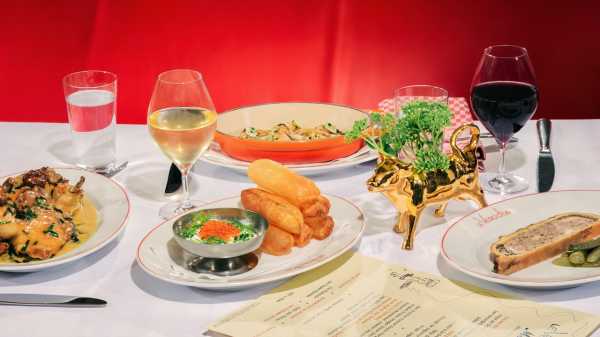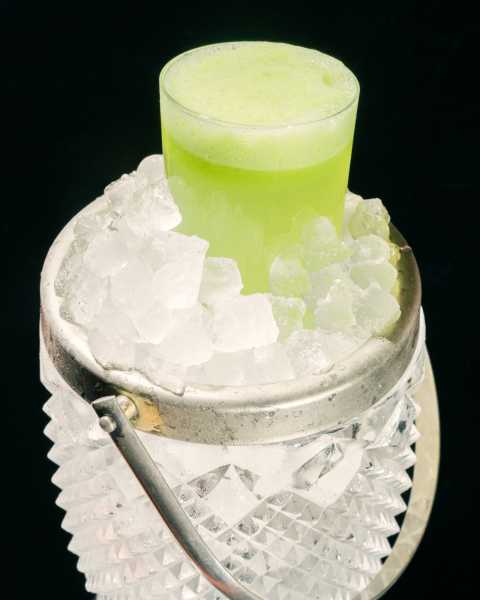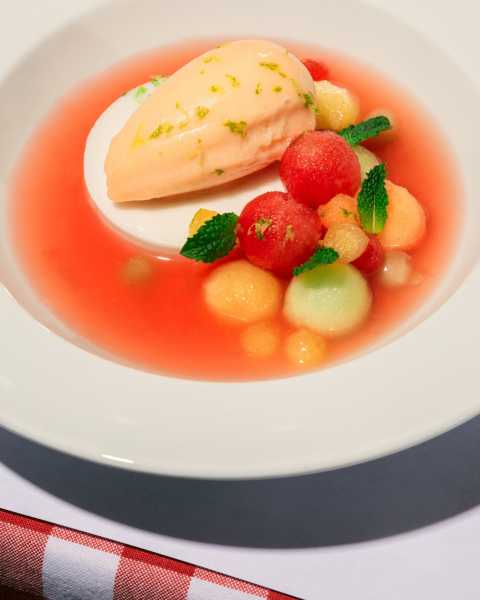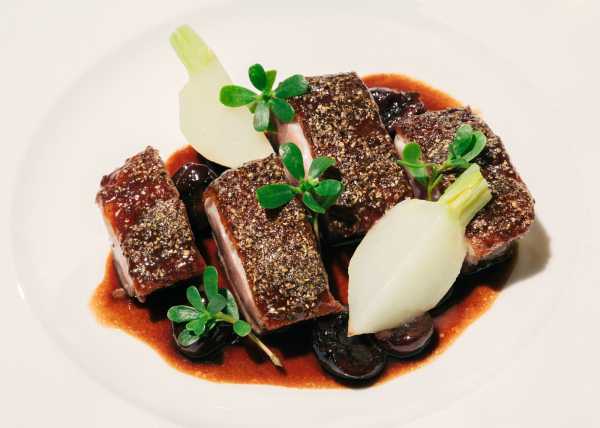
Save this storySave this storySave this storySave this storyYou’re reading the Food Scene newsletter, Helen Rosner’s guide to what, where, and how to eat. Sign up to receive it in your in-box.
Le Veau d’Or first opened, in 1937, on a tony stretch of East Sixtieth Street. A small, wood-panelled room a few steps below street level, with lipstick-red booths and a teensy bar, it was one of a slew of puckish little French bistros in the neighborhood. Nearly ninety years later, it is the city’s oldest surviving French restaurant, and the only one of its original cohort that remains. Over its near-century of operation, Le Veau d’Or has changed little, even as the societal tastes around it have churned. Once a white-hot ticket, packed with celebrities and the beau monde, over the decades it declined into a fusty throwback—a dreary haunt for old-timers. Five years ago, after a long professional courtship, the chef-restaurateurs Lee Hanson and Riad Nasr, the duo behind the polished, high-production-value brasseries Frenchette and Le Rock, bought the restaurant from the Tréboux family, its longtime owners, and closed it for an extended rejuvenation period. It finally reopened last month. Despite being facelifted and spit-shined, it remains anachronistic, backward-looking, obsessed with its own history. It’s one of the coolest restaurants I’ve been to in ages.

The Trou Normand shot, made with frozen Armagnac and fresh green-apple juice.

A dessert of soupe de melon features orbs of the fresh fruit, an airy blancmange, and a quenelle of sorbet.
You certainly don’t need to know anything about the backstory of Le Veau d’Or before stepping inside for dinner, though plenty will reveal itself in the course of the evening. Even the format of the meal is proudly archaic: as in the past, it’s an obligatory prix fixe that, for a relatively reasonable hundred and twenty-five dollars, encompasses your choice of an appetizer, an entrée, and a dessert, with a salad course of lettuces vinaigrette that arrives, très Frenchily, after the main course. An old menu, likely from the nineteen-forties or fifties, hangs in a frame on one wall, not far from the windowed table that Orson Welles is said to have preferred back in the day. The list of dishes, handwritten in a swooping, Gallic cursive, is surrounded by a printed illustration of jolly cherubs dressed in tutus and chefs’ toques leading a reluctant calf to its somewhat brutal culinary fate. The same half-naked Kewpies adorn the present-day menu, though the cleaver has been swapped out for a smaller, less ominous dinner knife. The present-day bill of fare, too, is only lightly modernized: les escargot provençale (snails broiled under a blanket of butter, garlic, and tomato concasse), tete de veau ravigote (crispy cubes of veal headcheese), chilled lobster macédoine, a delightfully wobbly oeuf en gelée—a whole boiled egg suspended like a specimen in an amber aspic of consommé—that calls back to what the Times, in a scathing 1977 review, highlighted as one of the restaurant’s very few dishes worth recommending.

The appetizer menu includes goujonettes, or fried strips, of fluke served with tartar sauce.
Thank goodness that the hit rate, these days, is considerably higher. The starters range from the straightforward—a plateau of oysters with pinky-size chipolata sausages; a chilled arrangement of ham, oeufs mayonnaise, and celery rémoulade—to the fussily extravagant, such as artichokes à la grecque, the tender hearts meticulously plated with a rainbow of vegetables, including flower-shaped carrots and tweezer-placed individual leaves of herbs. You can hardly go wrong, though it would be the height of tragedy if not one person at the table ordered the frogs’ legs persillade, a cancan line of amphibian gams in an audibly sizzling bath of butter and garlic that a server oomphs up, upon presentation, with a squeeze of lemon. You could try to be elegant with a knife and fork, but the correct move is to eat them with your hands, like chicken wings. (The old cliché is true: they do taste just like chicken.)

The magret de canard—the breast of a duck whose liver has gone for foie gras—is presented atop a pile of stewed cherries.
There are no add-ons at Le Veau d’Or, no sneaky little ways the restaurant tries to boost the price of your meal. There’s something perversely democratic about this, in a town full of restaurants smearing supplemental caviar on ice cream willy-nilly. On my first visit, I was fascinated to notice myself trying to somehow game the menu, strategically selecting the dishes that might get me the most bang for my buck. Why would a person choose to begin their evening with a petite omelette or a tomato salad when she could have the much ritzier pâté en croûte, or pommes soufflés with crème fraîche and trout roe? The answer, I realized, within the oddly liberating confines of the fixed-price format, is simply because she wants to: pleasure is its own (not insignificant) form of value. The omelette is silken and exquisite, a showpiece of technical precision, though the pâté is, too: savory and well-spiced in its pastry frame, shot through with golden veins of jellied consommé. The pommes, like three-dimensional potato chips, paper-thin and hollow inside, are awfully fun to snap open and pile with the cream and ruddy fish eggs.
This feeling of having entered a perfectionist time machine carries through to the next course. Crisp-skinned, pepper-crusted, perfectly tender magret de canard—the breast of a duck whose liver has gone for foie gras—is presented atop a pile of sweet and tangy stewed cherries, pink on pink. The chicken en cocotte, braised with cream and savory vin jaune from the Jura region, is one of those swoony classics that are both rustic and opulent at once; it comes alongside a dish of buttered Carolina Gold rice pilaf, a pairing so unexpectedly antiquated, so self-confidently out of style, that it circles around to fresh and silly and brilliant, straight out of an Alice B. Toklas dinner party. A one-and-a-half-pound lobster is poached to a satin texture and served chilled, in its shell; its accompanying macédoine, a salad of finely diced vegetables, gives it the air of something you might be offered at the most elegant possible luncheon (not lunch, luncheon). There’s a nice little steak, your choice of au poivre or with bearnaise, with nicely golden fries, but I would advise exploring the gigot of lamb instead: thick, ruby-rare slices with the tenderness and intensity of prime rib, next to a pile of pearlescent white beans fragrant with rosemary and tarragon.
Helen, Help Me!
E-mail your questions about dining, eating, and anything food-related, and Helen may respond in a future newsletter.
This sort of old-fashioned food, in this sort of old-fashioned room, inevitably brings a certain air of pomp to the proceedings. But the most marvellous thing about Le Veau d’Or is how human and welcoming it feels. Despite the dapper pink jackets worn by the staff, there’s little starch to be found. Service is attentive, but in the way that friends are attentive. Jorge Riera, the restaurant’s wine director and, to my mind, a true oenophilic genius, wanders the puzzle-piece dining room dispensing splashes of this and that from his all-French list and offering tips for how best to get the caviar rouge to stay on a shattered pomme soufflé. The drinks menu includes a strikingly inventive Martini “our way” (it’s a two-in-one: a desert-dry gin cocktail, and a Sidecar spritzer of vermouth and Vichy Catalan), a take on the Marie Antoinette that’s titillatingly garnished with an inverted raspberry, and an unimpeachably genteel list of shots. When it’s time for dessert (overseen by the pastry chef Michelle Palazzo), trays emerge bearing grand old classiques like strawberries sabayon and a soupe de melon that features orbs of the fresh fruit in an airy blancmange, with a quenelle of sorbet. But nearly every table seems to understand the necessity of ordering the île flottante (floating island), a laborious confection of ancient pedigree, and one of Le Veau d’Or’s longtime signatures. It’s a swirly whip of meringue drizzled with caramel and studded with slivered almonds, adrift on a puddle of sweet, smooth crème anglaise. It’s been around for ages, it’s few people’s idea of a good time, it was nearly forgotten—but, in the right hands, a stodgy classic becomes a giddy delight. ♦
Sourse: newyorker.com







